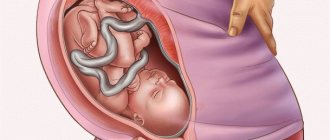Why is discharge brown in early pregnancy?
In a healthy pregnant woman, the absence of any dark spotting is considered the norm.
But sometimes brown discharge during early pregnancy is normal and does not threaten the health of the mother and fetus. However, only a doctor can say for sure whether this condition is normal. Therefore, for any spotting or heavy brownish, brown or bright red discharge, you should consult a specialist.
What you need to know about a cold at 4 weeks pregnant?
Remember - a slight increase in temperature is the effect of progesterone. Getting sick at four weeks is easier than ever before. With the onset of pregnancy, immunity decreases. This is a protective mechanism that comes into play during pregnancy. For the mother’s body, the fetus is only half “its own”. The woman's immune system perceives it as a foreign organism. Therefore, the immune defense is temporarily weakened.
Try to avoid hypothermia, public places and contact with people with colds. It is very difficult to be treated without harming the embryo at this time. Be careful! Acetylsalicylic acid should not be used to reduce fever. It can provoke termination of pregnancy.
Possible reasons
One of the reasons for the appearance of spotting is considered to be the process of formation of a small amount of blood during the implantation of a fertilized egg. This usually happens in the 3rd week of pregnancy; brown discharge is the result of rupture of blood vessels during the process of attachment of the egg to the walls of the uterus.
Also, scanty brown discharge in early pregnancy can develop due to low progesterone levels. The so-called “reproductive system memory” leads to the production of a small amount of blood on the day when your period is due to begin, even if pregnancy has already occurred.
There are also more dangerous causes that threaten the unborn child and the health of the mother - ectopic pregnancy or spontaneous abortion.
Implantation bleeding
One of the safest physiological causes of brown leucorrhoea is implantation bleeding. This condition at 3-6 weeks of pregnancy is considered normal.
Conception in the female body is accompanied by many processes. Around the middle of the menstrual cycle, during ovulation, a mature egg leaves the ovary, meets a sperm and is fertilized, forming a blastocyst, which then attaches to the inner epithelial layer of the uterus. It is at this stage that a small amount of blood may occur, lasting from a few hours to two days.
Such bleeding can only begin if the egg moves through the fallopian tubes and enters the uterine cavity. By introducing itself into the epithelium, the fertilized egg damages the vessels in which the mucous membrane is rich, but this is also possible during the movement of the egg through the pipes. When the embryo attaches to the epithelium, bleeding stops.
This phenomenon is quite rare, so experts often classify it as a pathology that indicates some kind of problem in women’s health. However, such a daub is not dangerous and does not affect the development of the fetus.
Progesterone deficiency
Progesterone deficiency refers to an endocrine disorder, which is manifested by a decrease in the production of the hormone progesterone by the corpus luteum in the second phase of the cycle. This condition can be determined by symptoms such as pain during menstruation, irregular cycles, infertility and a possible pathological course of pregnancy.
Deficiency results in light brown discharge in early pregnancy. If conception is successful, low levels of progesterone can provoke spontaneous miscarriage, the development of ovarian cysts, mastopathy, and endometritis.
Insufficiency that causes discharge in the 3-5th week, even if pregnancy continues, threatens with dangerous complications - oligohydramnios, fetal hypoxia, premature birth. During treatment, progesterone preparations are prescribed in the form of tablets, suppositories, capsules or solutions for intramuscular administration.
Spontaneous miscarriage
A miscarriage that occurs before the 14th week is considered early, and a miscarriage that occurs before the 24th week is considered late. In the first case, standard periods begin, in the second, labor begins.
Light brown discharge in the early stages of pregnancy may indicate a threatened miscarriage or incipient fetal rejection. In the first trimester, symptoms are practically not expressed, but in all cases there is profuse bloody smear.
The appearance of brownish, light secretion is characterized by the threat of miscarriage. Additionally, this condition is accompanied by nagging pain, and detachment of the fertilized egg is expected.
When the fetus is spontaneously rejected, heavy bleeding begins. If the embryo remains in the body of the uterus, the woman's condition gradually worsens. In case of a frozen pregnancy, curettage is performed or, when the period exceeds 20 weeks, labor is stimulated.
It can be difficult to independently determine the nature of the bleeding: menstruation or miscarriage. Therefore, we recommend that you study this issue in more detail and do not put off visiting a doctor.
Regressive pregnancy
Frozen pregnancy is registered in almost 15% of cases. Most often, this condition is observed in the first trimester. The main symptoms are:
- sudden cessation of drowsiness and nausea;
- irregular bleeding;
- nagging pain in the lower abdomen;
- discrepancy in the size of the uterus during examination;
- disappointing results of the study - a sharp decrease in the level of hCG, absence of fetal movements and heartbeat according to ultrasound;
- diagnosing anembryonia (empty fertilized sac).
Typically, the process of fetal development stops at 5-15 weeks of pregnancy; brown discharge in this case is accompanied by subtle changes in the condition, the appearance of bloody leucorrhoea, which occurs only 2-4 weeks after the death of the fetus. In addition, bleeding may develop, requiring hospitalization. The longer the pregnancy, the more likely the risk of heavy bleeding and subsequent complications.
If the diagnosis is confirmed, the doctor decides to scrape or vacuum clean the frozen pregnancy.
Ectopic pregnancy
Symptoms of an ectopic condition are felt much earlier, usually at 4-7 weeks of pregnancy. This is due to the fact that the fetus, especially located in the fallopian tube, begins to damage the blood vessels, causing the appearance of bloody smears. If the fetus is located in the abdominal cavity, which is much less common, symptoms may appear later.
Also, an ectopic pregnancy is accompanied by symptoms such as acute or nagging pain in the lower abdomen, fever, and nausea. Some women noted that they experienced toxicosis during an ectopic pregnancy. The nature of the discharge also changes - it has a bright scarlet hue, an unpleasant odor, especially if an inflammatory process is involved, is not related in timing to menstruation or possible implantation bleeding, and its intensity increases.
The development of bleeding occurs when the tube ruptures or the fetus separates. The appearance of symptoms of ectopic pregnancy is always preceded by a delay, and the onset of characteristic symptoms is also possible - toxicosis, drowsiness, changes in taste preferences.
Ectopic cervix
Pseudo-erosion, which is also called ectopia of the cervix, also affects pregnancy. Against the background of hormonal changes, changes in the structure of the cervical tissues are possible. Ectopia does not in any way threaten the development of the fetus and the health of the woman; it cannot be treated during the gestational period and can go away on its own after delivery.
In rare cases, an inflammatory process – cervicitis – develops against the background of ectopia. The main manifestations of this disease are unpleasant-smelling discharge. Ectopia also provokes the appearance of minor spotting in the early stages, which occurs due to damage to the tissue of the vaginal mucosa and rupture of small vessels.
Complete erosion of the cervix during an interesting position does not require cauterization, since the procedure can cause bleeding and even miscarriage. Complex therapy is prescribed only after childbirth, but ulceration may disappear on its own.
Cervical polyp
Polyps are benign growths and are most often discovered during a pregnancy examination. Also, a polyp may appear after conception due to changes in hormonal levels.
Single formations of small sizes do not manifest themselves. The main symptom is the profuse production of whitish mucus. If polyps are accompanied by other diseases, brown discharge, periodic pain in the lower abdomen, and cycle disruption may occur. Along with polyps, fibroids, ovarian cysts, and colpitis are often diagnosed. The relationship between the appearance of polyps and chronic and acute sexually transmitted infections - persistent herpes, candidiasis, trichomoniasis, chlamydia - has also been proven.
Removal of a polyp during pregnancy is not carried out if its size does not exceed 1.1 cm. With a large volume of growth, inflammation of the cervix is caused, which can negatively affect the development of the fetus. In this case, the formation is excised. Hormonal therapy is used only when glandular polyps occur and after childbirth.
Pathological discharge
At the beginning of pregnancy, when the body is just beginning to rebuild, immunity drops sharply, so some health problems become more active.
Bloody spot
This symptom is the most common and suspicious. Liquids colored beige, pink, scarlet or dark require mandatory examination.
Erosion
The appearance of brown discharge after exposure during intimacy or as a result of medical procedures accompanies the pathological condition of the cervix. This is a very common disease that rarely leads to serious consequences. It is treated after childbirth by cauterization with a laser or electric current.
Polyp
With such education it is more difficult to get pregnant and keep a child. The growth, like the IUD, provokes rejection of the embryo immediately after implantation. However, there are many cases of coexistence of a polyp and a child in the uterus before the birth itself. There is no direct threat, so there is no need to terminate the pregnancy or remove the formation yet. If necessary, the operation is performed at 16-20 weeks. With this pathology, bloody discharge of various types occurs - pink, brown, streaked. Sexual intercourse can provoke their appearance.
Attention! The rapid growth of a polyp during pregnancy can be alarming. With hormonal changes, these benign formations sometimes become cancerous.
Other problems
Smears with blood occur in women who already had tumors before pregnancy, including fibroids, cysts, as well as hormonal diseases - hyperplasia, endometriosis, adenomyosis.
Risk of miscarriage
This is the first thing that will be considered a diagnosis in the presence of bloody discharge. It is very difficult to understand at such an early stage, but all the described conditions are accompanied by abdominal pain and brown and red smudges:
- Retrochorial hematoma is a consequence of a lack of certain hormones when the fetus is partially rejected. They are treated with Utrozhestan and Duphaston, as well as hemostatic and healing drugs, for example, Tranexam. At the same time, spasms are relieved with Papaverine or No-shpa, and vitamins are prescribed;
- Placental abruption is a significant gap at the site of attachment of the embryo to the uterus. Leads to frozen pregnancy and miscarriage, eliminated by the same means as retrochorial hematoma. In fact, this is a neglected case of hers;
- An ectopic pregnancy is diagnosed by ultrasound from the 5th week. At this stage, a brown spot and pain may only appear on one side of the lower abdomen;
- Fetal death in utero can be diagnosed if the hCG level ceases to correspond to the level of 4 weeks.
Attention! Scarlet and dark red discharge during pregnancy is a sign of a critical condition. The woman should be put down and an ambulance should be called.
Copious white discharge
If there is severe itching, this is a sign of thrush. They can be creamy and lumpy, or very dense and grainy. During pregnancy, Candida fungi multiply rapidly. For curdled discharge in the first trimester, you can use Pimafucin suppositories or others as agreed with your doctor.
Purulent
Yellow and greenish discharge with a rotten odor occurs with STDs. If the inflammation is provoked by Trichomonas, they are foamy; when gonococci multiply, they are mucous.
Light green shades of creamy leucorrhoea with a fishy odor are characteristic of bacterial vaginosis, a disease that is not sexually transmitted. The reason is the proliferation of its own microorganisms - anaerobes, staphylococci, and more often gardnerella.
For treatment, suppositories are selected that are safe in the first trimester and effective in destroying the identified pathogen.
Liquid like water
Such discharge is observed in cases of oncological tumors of the cervix and uterus; they have an unpleasant odor and a gray or greenish tint. When the appendages become inflamed, a very liquid substance also appears. A viral infection of the genital organs is characterized by watery leucorrhoea, rashes on the mucous membranes and itching.
Sticky and transparent
Glassy discharge is a symptom of chlamydia proliferation. They occur with moderate irritation of the mucous membranes and with an atypical, but not pronounced odor. It is quite difficult to cure the disease; drugs are used that pose minimal threat to the child. As a rule, drug therapy is prescribed only from the 12th week.
Attention! Infections can cause miscarriage, problems with embryo development, and serious illnesses in the child after birth.
Necessary studies and analyzes
To determine the nature of brownish discharge in the early stages, the following range of examinations is carried out:
- transvaginal ultrasound examination;
- determination of hormonal profile;
- colposcopy;
- smear analysis;
- biochemical and/or general analysis of blood and urine.
A doctor's help is required immediately if a woman notices increased bleeding, a change in the color of secretion to bright red or scarlet, the appearance of clots, fever, pain in the perineum and lower abdomen, faintness, weakness, dizziness.
Changes and sensations in the abdomen
The expectant mother “attributes” many of the subjective sensations that arise to premenstrual syndrome (PMS). Indeed, to some extent these manifestations are similar. Often, during this short period of time, a woman simply does not realize that she is already expecting a baby.
In some cases, the expectant mother may experience a pulling sensation in the lower abdomen. They can be caused by both physiological and pathological reasons.
The active growth of the child in the uterus causes the expectant mother to have an aching and tingling lower abdomen. This symptom can occur at any time of the day. The severity of this manifestation can be very different. Some women who have already become mothers note that at this stage of pregnancy they did not feel any discomfort.
The pathological course of pregnancy, leading to its spontaneous termination, may be accompanied by the appearance of spasmodic contractions in the lower third of the abdomen. Typically, such symptoms occur suddenly against the background of the woman’s complete well-being.
Changes in hormonal levels can lead to an exacerbation of some chronic diseases that the expectant mother suffers from. So, a pregnant woman may feel that her ovary hurts or tingles on the right or left side. Typically, this symptom manifests itself in expectant mothers who have neoplasms or various ovarian cysts.
Slight pain in the lower abdomen may be present in all pregnant women. It is unfavorable if this symptom begins to progress.
In this case, the doctor may recommend that she undergo a transvaginal ultrasound. This examination may be necessary to exclude concomitant pathologies that could lead to the appearance of these adverse symptoms in a pregnant woman.
To learn why your stomach hurts in the early stages of pregnancy, watch the following video.
How to count?
The 3rd week of embryonic pregnancy corresponds to one week of missed periods.
Obstetric and true pregnancy periods usually differ by about 2 weeks. This is due to the fact that doctors count the gestational age not from the date of conception, but from the date of the start of the last menstruation, as from a certain moment.
In reality, pregnancy begins later - after ovulation, fertilization of the egg by sperm and implantation of the fertilized egg into the uterine wall. However, it is not possible to accurately determine the time of all these events. All that remains is to record the date of the last menstruation, add 280 days to it and get the estimated date of birth.
But at 3 weeks of pregnancy, birth is still a long way off. If a woman has a 28-day cycle, then ovulation occurred on day 14, and pregnancy occurred a little later. It's already 3 weeks of pregnancy, and the woman is just starting to worry about the delay. Of course, if the pregnancy is planned or was the result of IVF, then the woman can know about pregnancy at 3 weeks more definitely.
In fact, pregnancy has not yet occurred, since this will happen only after implantation of the fertilized egg, but the corpus luteum has already begun to produce progesterone, so the next menstruation does not come. The fertilized egg, if conception has occurred, moves into the uterine cavity and looks for a convenient place for implantation.
Progesterone has already done everything necessary for this:
- relaxed the muscles of the uterus to avoid spontaneous contractions;
- prepared the mucous membrane;
- weakened immunity for successful attachment;
- affects the central nervous system of a woman so that she becomes less nervous.
Other hormones, such as estrogen, also prepare the body for pregnancy.
If the countdown is from the date of conception, that is, the moment of fertilization of the egg by the sperm, then even in the case of late implantation it has definitely already occurred. This means that an express pregnancy test will definitely show two lines. By this time, the level of the hCG hormone, which is produced by the membrane of the fertilized egg, has already increased enough for the pharmacy test to recognize it. Also, a woman’s blood test will show a higher level of hCG: pregnancy has occurred and is developing.
Brown spotting during pregnancy 6-7 weeks
6th week of pregnancy, spotting started (not often), first yellow then brown, this is already the 3rd day (((nothing hurts. Tomorrow I’m going to the doctor, have any girls had this? Does this really mean a miscarriage? But what about those girls who have Do menstruation last until 4 months during pregnancy? I know a lot of people like that. Help me calm down. I’m experiencing a long-awaited pregnancy
I also started to have a small brownish smudge. I immediately called a gynecologist I knew, she told me to take 4 tablets of Duphaston and then call her back. Since she was not in the city, I went to the hospital to see another G, there I did an ultrasound, they told me that everything was fine, I don’t need to take Duphaston, it happens that the baby is alive 6- 7 weeks come when you are 10-11 weeks. They prescribed me iodofol, although I took pregnatal (it was canceled), so I asked for time off from work, came home, and lay in bed all the time. And then at night I had bleeding and everything went away on its own, my stomach didn’t hurt, it just ached a little. And when I arrived at the maternity hospital, they sent me for an incomplete abortion. Then a normal doctor explained to me that with such a short period of time it’s not worth taking duphaston, since it holds the uterus together, and if I had taken duphaston (then they wouldn’t have done a curettage, but opened the uterus alive). It turns out that the hormones are raging, but the uterus does not allow. In general, when I looked at what kind of problems the girls come with, I inadvertently thought that it was good that for such a short period of time, when he was not yet a person, but just a substance. Next time I will be much more careful. Good luck to everyone, don’t fall for bad doctors, good health to you and your children.
See a doctor immediately. This happened to me, they put it on hold for 2 weeks and injected it with hemostatic agents, so everything worked out. Now my daughter is 5 months old
I hope it’s not so scary for you, but when did this happen to me and also no one’s sky
Source
Woman's feelings
With the embryonic counting method, 3 weeks is the period when a woman begins to notice the first changes in her condition. For example, the sense of smell becomes more acute, and taste and olfactory preferences change. This is the very period when a woman really wants something salty, she is drawn to those foods that she usually does not like, and smells and tastes that previously seemed attractive irritate her to the point of nausea.
Another accurate sign of pregnancy at 3 weeks is pain in the chest. The mammary glands become denser, coarser, increase in size, and the nipples become more sensitive. Sometimes, already at this stage, a woman begins to be bothered by morning ailments, weakness, and nausea. The appetite may change, and it may even improve, and the woman almost constantly experiences slight hunger, the desire to snack, and, conversely, because of morning sickness, she does not feel like eating at all.
With the method of counting from the first day of the last menstruation, there are no sensations yet. The third obstetric week corresponds to one week of missed menstruation.
In the third week, according to the embryonic method, future organs and systems important for life are already formed in the child’s body. The neural tube, notochord, neural crest, as well as the heart, vertebrae, rudiments of arms, legs, spinal cord and brain, liver, lungs, intestines and kidneys are formed. The gill slits are already visible, from which the neck, lower jaw and tongue will later emerge. The first blood cells of the future baby are produced, and where the head and face will later be, the eye sockets, the rudiments of the ears and some glands appear.
During the third week, the uteroplacental circulation is formed: this means that now the development of the child is completely dependent on the mother, her diet and lifestyle. And if a woman, for example, abuses alcohol, then this causes serious damage to the developing embryo and most often ends in its death and rejection.
Therefore, if a woman is planning the desired pregnancy, she needs to carefully listen to her feelings already in the second phase of the cycle, when conception may have occurred.
In the third obstetric week of pregnancy, women are sometimes bothered by slight nagging pain in the lower abdomen and pink discharge. This may be due to the process of implantation of the fertilized egg, which prepares a place for itself in the mucous membrane of the uterus, as if scraping out some of the epithelial cells in order to penetrate deeper and more reliably. Since this process takes about 40 hours, the woman may feel discomfort. But most often they are taken as harbingers of the next menstruation. Actually, this is what will happen if the implantation is unsuccessful.
Modern medicine believes that up to 75% of attempts to implant a fertilized egg are like this. The woman does not know about the conception that has occurred; there are no physiological signs of it. Rejection of the fertilized egg occurs if any genetic defect occurred during conception, the woman was sick at that moment, was taking medications, was nervous, or underwent heavy physical exertion. In some cases, a completely healthy fertilized egg is rejected for no apparent reason.
If bleeding appears in the third week of counting according to the embryonic method, i.e. after conception, when the development of the embryo has already begun, then they are sometimes a symptom of a miscarriage. Especially if such discharge is accompanied by cramping pain in the lower abdomen.
A woman needs to be concerned if, in the 3rd week from the moment of conception, even slight spotting, possibly brown, appears. They do not necessarily look like bleeding; the discharge may be spotting.
Pain in the lower abdomen for many women is a sign of approaching menstruation. Particularly often, the lower abdomen is pulled in those women who suffer from premenstrual syndrome, as well as those who have anatomical features of the structure of the pelvic organs. Also, pain in the lower abdomen on the eve of menstruation can also be caused by natural causes. In this phase of the cycle, a woman’s body produces less endorphins - pleasure hormones, which causes a decrease in the level of potassium and magnesium in the blood, which can lead to pain, cramps, deterioration in mood and well-being.
But if a woman’s period is already delayed by about a week, and then pain occurs in the lower abdomen, this may indicate a possible short-term miscarriage. If pregnancy has already been determined, and the period is 3 weeks using the embryonic method, then the pregnancy can be saved.
If in the early stages of pregnancy a woman has a tightening in her lower abdomen or pain, like before her period, or pain in the lower abdomen, she should immediately consult a doctor.
Pregnancy 3 weeks from conception: Ultrasound and abdominal pain
Most women feel this, and the test is bought for double-checking. As soon as a new life begins to emerge inside, changes do not take long to arrive. There are several signs by which a woman can determine that she is interesting. Of course. situation, if there were prerequisites for this. Moreover, she can even become pregnant if she is 3 weeks from conception, and there are no changes in her external figure yet.
psycho-emotional signs of pregnancy
The most interesting thing is that most girls are naive and believe that the fetus begins to put pressure on the bladder, provoking the urge. During early pregnancy, frequent trips to the toilet are caused by hormonal changes. Therefore, if you have this symptom, think about what else it could be connected with.
Attention, not to be confused with pain! Stretching during pregnancy, especially in the initial stages, is a sign that the future fetus is attached to the walls over time. This goes away from the uterus around the 2nd month. Looks like Stretching for a period of a few days before if.
A little more about possible discharges. Also, spotting may appear in the 3rd week of pregnancy, but only a doctor can accurately diagnose it. There are also cases when brown ones appear in
Source
Expert advice
According to gynecologists, mild pain, even in combination with pink, but not bloody, discharge does not necessarily indicate a threat of termination of pregnancy. But in any case, it is better for a woman to stay in bed for several days and follow the doctor’s prescriptions. This will help maintain pregnancy if it has already occurred, or create favorable conditions for implantation. Doctors advise giving up physical activity and sports these days and trying to maintain a good mood.
If the discharge turns brown, the pain intensifies, and blood appears, you need to contact either the doctor who helped the woman prepare for pregnancy, or seek emergency medical help at an antenatal clinic or private clinic.
Modern medicine has tools that can prevent miscarriage.
For information on what happens in the 3rd week of pregnancy, watch the following video.
Third week of pregnancy
It is during the 3rd week that you may begin to experience the first signs of pregnancy. Read about what you need to know about fetal development!
It is very surprising that the genetic code of your unborn child is determined at the moment of fertilization. Her or his gender and all inherited personality traits, along with the color of eyes, hair, skin, body structure - everything was already determined when the sperm fertilized the egg!
At the end of this week of pregnancy, you may notice (this does not happen to everyone) slight spotting. This is the so-called implantation bleeding, which can be caused by the implantation of the embryo into the mucous wall of the uterus, which is very well supplied with blood (this process begins 6 days after fertilization of the egg). In any case, it is minor and occurs in a small proportion of pregnant women. Most expectant mothers do not notice any changes.
At the moment of birth, your baby is a small ball that consists of several hundred cells multiplying at an unimaginable pace. When it implants in the uterus, your body begins to produce a hormone called human chorionic gonadotropin, which tells the ovaries to stop producing eggs and triggers increased production of estrogen and progesterone (this keeps the uterus from shedding its lining, causes fetal growth and stimulates the development of the placenta).
Amniotic fluid begins to accumulate around the embryo, which serves as its protection throughout pregnancy. At this time, the formation of all the main organs of the fetus occurs: the brain, spinal cord, heart, arms, and appearance begin to develop. But in any case, the embryo is still very small and resembles more a group of cells than a child. It is the size of a pinhead and its length is approx. 0.15 mm.
Source
Spotting brown discharge at 3 weeks of pregnancy
Good morning planning and already accomplished mothers!
Share, maybe someone has had this... At the moment I am 3 weeks pregnant (5 weeks pregnant). Yesterday I started having brown spotting and a tug in my stomach on the right side. We, as conscious parents, would rather go to the hospital. After going to the gynecologist, we were told that we can’t see the testicle in the uterus, because... a short period of time... they do not establish a 100% uterine one and do not remove the absence of an ectopic one. They said that this kind of thing happens. I started drinking Duphaston and Noshpa. Maybe someone had this?
I also had this (((but I hit myself by accident, the doctors threatened to prescribe Duphaston a bunch of vitamins, I also took tests
At 4 weeks I started spotting and a few weeks later an ultrasound revealed that I was pregnant. So it’s better for you to urgently consult a doctor and go to bed. I keep my fingers crossed for you that everything goes well for you.
either a threat or ectopic... I had this happen with an ectopic
The second pregnancy was ectopic, the third was a miscarriage, now again I don’t understand what (
I don’t even know what to say... I don’t know how your ectopic progressed, when my discharge started the next day it was dirty and spotty... There wasn’t much pain, only after the operation the doctor told me that in 30 years in his practice the first case was My tube has already started to bleed and I calmly walked around the department without any pain... maybe I can try to do an ultrasound only with a good machine, we still have to find out something, there is also some kind of puncture to determine an ectopic pregnancy
Discharge after three weeks of pregnancy: normal and abnormalities
Signs of pregnancy at the end of the first month may be similar to the symptoms that appear before your period. So, due to changes in hormonal levels, a woman can quickly get tired and become irritable. Occasionally, a change in taste occurs, and intolerance to certain aromas is possible.
Symptoms are often recognized as impending menstruation, however, during conception there should normally be no bleeding. In some situations, bleeding may occur in women at 4 weeks of pregnancy; they are called implantation and do not pose a danger.
There is no reason to worry if the leucorrhoea is clear and odorless, thick and not too abundant. The appearance of blood, brownish smears, mucus with an unpleasant odor and pain may indicate a pathological process.
brown discharge in early pregnancy
Hello! Girls, please tell me there is a strong bloody discharge, this didn’t happen with my first child, now I’m 4-5 weeks old, tell me please, I’ll go for an ultrasound tomorrow.
Hello Olya, I have similar symptoms, tell me how much your hCG increased? My reading was 316 on December 29th, after almost 2 days of testing it became 453, the gynecologist can’t see anything in the uterus, although I saw it a week ago, he suspects an ectopic and today I started to see a little bit of brown discharge
Use and reprinting of printed materials from the woman.ru website is possible only with an active link to the resource.
The use of photographic materials is permitted only with the written consent of the site administration.
Posting intellectual property objects (photos, videos, literary works, trademarks, etc.) on the woman.ru website is permitted only to persons who have all the necessary rights for such posting.
Copyright (c) 2016-2018 Hirst Shkulev Publishing LLC
Online publication “WOMAN.RU” (Zhenshchina.RU)
Certificate of registration of mass media EL No. FS77-65950, issued by the Federal Service for Supervision of Communications, Information Technologies and Mass Communications (Roskomnadzor) on June 10, 2016.16+
Founder: Limited Liability Company "Hirst Shkulev Publishing"
Editor-in-Chief: Voronova Yu. V.
Editorial contact information for government agencies (including Roskomnadzor):
Bleeding and miscarriage
Bloody discharge in the early stages may be a symptom of miscarriage. It is often mistaken for the beginning of menstruation.
Several factors can lead to pregnancy failure:
- Infection.
- Drinking alcohol.
- Physical overload.
In the fourth week, the fetus turns from fertilized egg into an embryo. It reaches small sizes - 2 mm. Even a common cold can lead to pregnancy failure - the fetus is very vulnerable at this stage of development. Even a temperature of 38 can lead to miscarriage. Alcohol has a particularly detrimental effect on embryo development. Its use increases the risk of having a sick child and can also lead to spontaneous abortion.
An ultrasound scan at such an early stage is performed if there are medical indications for it. During this period, the fetus is actively growing, so with the help of a study it is possible to determine the presence of pregnancy, as well as possible anomalies.
It is important to conduct an ultrasound in the fourth week to determine possible pathologies of the patient’s reproductive organs. Timely detection of abnormalities allows us to determine the necessary treatment in the future. The study is carried out to promptly identify signs of ectopic pregnancy.
Brown discharge during pregnancy
Content:
Brown vaginal discharge is nothing more than blood or blood with mucus in small quantities, oxidized in the presence of vaginal microflora and oxygen. They can occur at any stage of pregnancy, both during normal course and in the presence of pathology. Therefore, it is strongly not recommended to panic in advance and create stressful situations for your body.
important However, you should remember that whatever the reason, self-diagnosis and self-medication are strictly prohibited.
If brown discharge appears, you should contact your gynecologist who is managing the pregnancy as soon as possible, or any other doctor if for some reason the first option is not possible.
Types of vaginal discharge
At the initial stage of bearing a baby, the concentration of female sex hormones begins to change. Nature came up with this so that the embryonic development of the child proceeds as it should. Changes in hormonal levels contribute to changes in the physiology of the female genital organs.
The appearance of a specific secretion from the vagina is also an important clinical sign characteristic of this stage of pregnancy. Vaginal discharge can vary greatly in color, volume and density.
Bloody
In the fourth week, a woman waits for her monthly menstruation to appear and, as a rule, is completely unaware that she is pregnant. That is why the appearance of bloody discharge from the genital tract does not cause her any concern. Many women may even confuse them with the “arrival” of their period.
If spotting appears with a slight delay, then the expectant mother begins to suspect that she is expecting a baby. In this case, she goes to the pharmacy for a pregnancy test.
During the first weeks of pregnancy, the concentration of human chorionic gonadotropin (hCG) in the blood increases. Pregnancy tests, which are sold in pharmacies, are based on the determination of this substance in the urine. In the fourth week, such a test will show a positive result.
At this stage of pregnancy, some women may experience specific spotting that resembles menstrual discharge. Their color can range from pinkish to crimson. Such discharge is usually not abundant.
Gynecologists note that such specific discharge is genetic in nature. A pregnant woman should ask her mother if she had the same symptoms during pregnancy. If such a fact is present, then the woman should definitely warn her obstetrician-gynecologist about this.
Under various conditions, “smear” from the genital tract may develop. The occurrence of these symptoms may be preceded by physiological causes. In this case, specific pregnancy hormones contribute to the appearance of bloody spotting.
Copious spotting and bloody vaginal discharge can be a clinical symptom of various pathologies of the reproductive organs. For example, pink and red discharge can be a manifestation of inflammatory diseases of the cervix.
Trauma to the delicate mucous membrane can also cause bleeding from the genital tract. Some women note that after having sex they notice small blood stains on their underwear. Couples should not limit their sexual activity during the normal course of pregnancy.
In order to distinguish normality from pathology, a clinical examination in a gynecological chair is required. During this examination, the doctor determines the condition of the reproductive organs and also identifies all signs of pregnancy.
Heavy bleeding is a very unfavorable clinical sign. If a woman bleeds heavily from the genital tract, this may be a manifestation of the onset of spontaneous abortion. As a rule, this symptom is accompanied by the development of severe pain in the lower abdomen. If these clinical signs appear, the expectant mother should urgently call for medical help.
Brown
Discharge from the genital tract may also be dark in color. Physiological reasons can also lead to the development of this symptom. Changing hormonal levels cause the expectant mother to have light brown discharge.
During the normal course of pregnancy at this stage, they do not have a foul odor and are released in small quantities. At the same time, the woman does not have pain in the lower abdomen. The general state of health does not change. If, against the background of the appearance of such discharge, the expectant mother has a nagging pain in the lower abdomen or lower back, then she should immediately contact her obstetrician-gynecologist
Light
In most cases, the vaginal discharge of the expectant mother at this stage of pregnancy is transparent. They can also be light or beige. As a rule, such secretions have no odor, or it is quite insignificant. The volume of such discharge from the genital tract varies.
During pregnancy, it is very important to monitor the hygiene of the external genitalia. To do this, a woman should only follow all the recommendations of her doctor.
Yellow
Yellowish, foul-smelling vaginal discharge is often a sign of the onset of a bacterial infection. Such pathologies, as a rule, are accompanied by a deterioration in the general well-being of the expectant mother. So, her body temperature may rise, and her lower abdomen may also become ill.
If yellow discharge appears, accompanied by an unpleasant odor, the expectant mother should definitely contact an obstetrician-gynecologist. The severity of adverse symptoms largely depends on the intensity and severity of the inflammatory process that has begun. The discharge can be either scanty or abundant.
After establishing the cause of the infectious disease, the gynecologist will prescribe comprehensive treatment for the expectant mother. In order to normalize the vaginal microflora and eliminate pathogenic microflora, the specialist will prescribe antibacterial drugs to the expectant mother. These medications should not be used uncontrolled.
Some antibacterial agents may have adverse effects on the fetus. There are certain medical indications for their use, so only an experienced doctor should prescribe them. When carrying out antibacterial treatment, effectiveness monitoring is mandatory. To do this, the doctor will definitely prescribe a repeat smear and general blood test for the expectant mother.
White curds
The appearance of such vaginal discharge is, as a rule, a sign of the onset of candidiasis. Candida fungi play an active role in the development of this disease. A decrease in immunity in the organs of the intimate zone contributes to their active growth and development.
A characteristic sign of this pathology is a cheesy vaginal discharge, which in most cases is accompanied by the development of itching. The itching can be quite severe and significantly disrupt the normal lifestyle of a pregnant woman.
When choosing treatment, experts give preference to drugs that have a detrimental effect on Candida yeast-like fungi and also do not negatively affect the fetus.
When is brown discharge normal?
There are two conditions in a woman when brown discharge refers to the normal (physiological) course of pregnancy, and they occur in 5-7% of expectant mothers.
Implantation of fertilized egg
In the presence of a fertilized egg and favorable conditions, 7-10 days after sexual intercourse, the fertilized egg implants into the inner lining of the uterus (endometrium) - implantation . During this process, several capillaries (the smallest vessels) may be damaged, releasing a minimal amount of blood, which, when combined with physiological vaginal discharge, gives a light brown or beige color. Normally, this condition lasts 1-3 days and is not accompanied by pain or discomfort, but by cramps in the lumbar or abdominal area. The discharge goes away on its own and does not require any action.
Removal of the mucus plug
Refers to the normal course of the third trimester of pregnancy and can occur 2-3 weeks before the onset of labor. This is due to the fact that the cervix is already ready for childbirth, loose, shortened, with increased blood flow. The mucus plug, which protects the uterine cavity and the baby from external infections, comes off on the eve of birth, touches the outer surface of the cervix and can cause irritation of several capillaries and a brownish discharge. The duration of such discharge can be no more than 1 day. In this case, the woman should not feel any discomfort.
additionally The same effect occurs with any gynecological examination late in pregnancy or after sexual intercourse.
Fetal development
The embryo, or future fetus, at the 4th week of pregnancy completes its journey to the uterus, passing the fallopian tube, and is freed from the protein membrane. Due to this, it acquires the ability to adhere to the wall of the uterus. Then its surface cells begin to intensively produce enzymes, with the help of which the embryo lyses (dissolves) the endometrial epithelium and blood vessels. This allows it to penetrate the wall of the uterus and “grow”.
The first close contact with the maternal body appears. The released blood during the destruction of microvessels is the first nutrients received by the fetus from the female body. Until this moment, the embryo lived and developed on the “energy reserves of the egg.” From this time on, all toxic substances, medications, and alcohol can freely enter the newly born body. The fetus at 4 weeks of pregnancy is very vulnerable and not protected.
In the first trimester
The first trimester can be called critical for a woman and her unborn child, because the body experiences stress and a number of changes, the fertilized egg quickly transforms into an embryo and fetus, and many organs are formed. That is why during this period any bleeding , including brown, most often develops in the presence of any pathology in a woman or a developing baby and is quite severe and dangerous .
Risk of miscarriage
The first and most common cause of brown discharge in the first trimester. For various reasons (most often from a lack of progesterone), the fertilized egg or embryo can detach from the endometrium, damaging blood vessels and causing brown vaginal discharge. Their quantity can vary from scanty to quite abundant, color - from light brown to brown-red. This depends on the severity of the threat of miscarriage and damage to the walls of the uterus.
The threat of miscarriage is accompanied by the following signs:
- nagging or cramping pain in the lower abdomen or lower back;
- nausea, vomiting;
- weakness;
- feeling unwell.
dangerous In this case, you should immediately call an ambulance and begin urgent treatment. Progesterone drugs, hemostatic agents and strict bed rest are usually prescribed.
Ectopic pregnancy
In rare cases, the fertilized egg may become fixed not in the uterine cavity, but in the fallopian tube (less commonly, in the ovary, on the cervix, in the abdominal cavity). This condition threatens the health and sometimes the life of a woman. As the embryo grows, the tube stretches and at some point ruptures, causing internal bleeding.
Brown discharge - a threat of miscarriage?
Even more interesting:
Unidox for acne
Ovarian inflammation symptoms
It is the sudden termination of pregnancy that causes the most concern among women. More and more questions related to the symptoms of this process appear on the Internet every day:
"I do not know what to do. We finally managed to conceive a child, so I worry about everything. I never got used to the spotting during the 5th week of pregnancy, but today there is much more of it. My stomach and back also hurt.”
We hasten to report that this woman managed to maintain her pregnancy, because all the participants in the conversation unanimously advised her to immediately go to the hospital. Just at the appointment, bleeding began, but timely medical assistance corrected the situation.
It is worth noting that during this period the chance of saving the fetus is 50 to 50, and 2 out of 10 women face this problem. At first, a slight bloody secretion is noted, which increases in volume and darkens over time, but treatment can help if addressed in time.
In the second trimester
In the second trimester, brown discharge is a sign of the development of one or another pathology of fetal development and requires mandatory contact with a gynecologist for timely diagnosis and treatment. The main reasons are listed below.
Placental abruption
It is the most common cause of bloody discharge ranging from light brown and brown to bright red, from scanty and spotting amounts to heavy discharge. Abruption of a normally located placenta threatens the lives of both the mother (risk of extensive blood loss) and the developing baby (lack of nutrition and oxygen). May occur against the background of:
- stress;
- poor environmental situation in the place of residence;
- eating disorders;
- excessive physical activity;
- concomitant pathologies in women, etc.
The placenta can detach in areas of varying sizes:
- from a small area - with spontaneous development of a hematoma (practically does not affect the course of pregnancy and does not require serious treatment measures);
- to large areas - with continued progressive development of the condition (requires immediate treatment, up to cesarean section).
important This condition is most often accompanied by pain in the lower abdomen of varying severity, discomfort in the lumbar region, dizziness, fainting, etc.
Placenta previa
This is a condition of the pathological location of the placenta, when it completely or partially covers the uterine os (the area where the uterine cavity connects with the vagina - the place where the baby comes out during birth naturally). This leads to the fact that as the fetus grows, the load on the placenta and its vessels increases, which can cause periodic, spotting, brown discharge.
Presentation is most often accompanied by:
Throughout the entire period of gestation, it is necessary to carefully monitor the woman and baby to prevent the premature birth of an unformed child, bleeding, intrauterine growth retardation (IUGR), and intrauterine hypoxia.
Delivery with placenta previa is almost always carried out by cesarean section.
Premature birth
dangerous Starting from the 20th week of gestation, premature onset of labor is possible.
Most often it occurs due to infections in the mother and fetus, frequent stressful situations, concomitant pathology in women, etc. Brown discharge may occur when the cervix opens and precedes the appearance of red bloody discharge and the release of amniotic fluid.
This condition is also accompanied by severe cramping pain in the abdominal area and nagging pain in the sacrum. Requires immediate medical attention, hospitalization in an obstetric hospital and delivery. In an extremely rare case, with an immediate response from a pregnant woman, premature birth can be stopped and the gestation of the fetus can be extended as much as possible until it is more ready for independent life.
Determining the term
Doctors consider week 4 to be the first trimester of pregnancy. At this time, the first specific changes begin to occur in the female body. The presence of a small embryo in the uterus already contributes to changes in the hormonal levels of its mother.
To determine the baby's age during its embryonic development, specialists use a special counting system. It includes obstetric weeks and months. This method differs from the calendar method, which is mainly used by expectant mothers. The fourth obstetric week corresponds to the second week from fertilization.
There are two main ways to calculate the period - obstetric and embryonic. In the first case, the beginning of pregnancy is the first day of the last menstruation. This method is considered universal; all gynecologists use it. Based on it, the date of birth is calculated.
The second option is as follows: beginning - the first day of the last menstruation of 14 days. When calculating the true period of pregnancy from conception, it is believed that ovulation occurs in the middle of the cycle.
Signs and symptoms
At 4 weeks of pregnancy, there should normally be no bleeding. Therefore, one of the signs is a delay in menstruation, despite the presence of symptoms characteristic of this process. A variant of the norm is the appearance of implantation bleeding.
The breasts swell and the nipples may become more vulnerable and painful. These changes are associated with the restructuring of hormones. Mood and eating habits may change, fatigue and drowsiness may appear.
Each woman’s sensations are different - some do not notice any changes, others see significant changes in the body and general condition. Nagging pain in the abdominal area is possible, especially in those girls who have had painful periods before. You should pay attention to this symptom - perhaps the tone of the uterus is increased, there is a risk of freezing the process of pregnancy and miscarriage.
Leucorrhoea that is colorless and odorless and thick is considered normal. Bloody and brown discharge indicates the development of pathological processes. Such discharge may be mistaken for menstruation, but it is often a symptom of spontaneous abortion. Various factors lead to freezing at such an early stage - infections, alcohol, physical activity.
During the first months of bearing a child, the female body experiences stress and changes in the concentration of hormones occur. These processes can lead to vaginal discharge. As a result, leucorrhoea appears that has a different color, viscosity and volume.
Regardless of the stage of pregnancy
At any stage of gestation, it is possible for a woman to develop or worsen an existing pathology, which is also often accompanied by brown discharge.
Cervical erosion
information It is a fairly common pathology in modern women and in almost all cases it occurs at a young (even teenage) age.
It is a violation of the structure of epithelial cells, ulcerations on the mucous membrane of the cervix. Brown, scanty, slightly spotting discharge during pregnancy occurs after contact of the damaged area with a foreign object (gynecological examination, sexual intercourse). Most often, they are not accompanied by any additional symptoms, disappear after 1 day and do not require medical intervention during pregnancy.
Inflammatory and infectious processes of the genital tract
Any sexually transmitted infections (both sexually transmitted and common bacterial) can cause brown spotting at any stage of gestation. A woman could become infected with an infection many years before conception and be a carrier of the infection, and against the background of hormonal changes and a somewhat reduced immune system, these bacteria became more active, their numbers increased, and a clinical picture of the disease arose.
A man who became a source of infection in a woman could get the disease not only through sexual contact, but also through illness:
- cystitis (inflammation of the bladder);
- prostatitis (inflammation of the prostate);
- urethritis (inflammation of the urethra), etc.
In addition to brown discharge, a woman may be bothered by:
- itching of the genitals;
- unpleasant odor of these secretions;
- viscous consistency;
- discomfort in the lower abdomen and pelvis.
information The most common treatment is antibiotics in the form of suppositories, vaginal tablets or oral tablets, with minimal exposure to the fetus.
Injuries to the vagina and cervix
This condition can occur due to domestic or violent damage. In cases where the injury is minor, the disruption of the integrity of the mucous membrane is insignificant, the discharge may be brown or brown-red, accompanied by discomfort in the area of the injury and itching. Examination by a gynecologist in the speculum also causes discomfort and increased bleeding. Treatment depends on the extent of the damage, ranging from disinfectant solutions to surgery.
Polyps in the vagina and cervix
Benign small neoplasms on a thin stalk can be present in the expectant mother both before pregnancy and can manifest themselves at any time during pregnancy. At the slightest touch to the polyp (sexual intercourse, examination by a gynecologist, etc.), it begins to bleed. This manifests itself as brown spotting and is not accompanied by additional symptoms.
Treatment during pregnancy is generally not carried out, but after delivery these tumors should be removed , because over time the process of degeneration of cells into malignant ones may begin.
Pregnancy period - 3 weeks: discharge that should alert you
Discharge that occurs during pregnancy is not always a sign of abnormal fetal development. However, some may actually cause concern for a pregnant woman.
Changes in a woman's discharge
Discharge in the third week of pregnancy can be very different. Colorless or slightly whitish marks on the gasket are normal. They appear due to the normal functioning of the female body and the production of hormones that are designed to maintain pregnancy.
“Spotting” in the third week of pregnancy may cause concern. Such discharge may indicate detachment of the ovum or pathology associated with an ectopic pregnancy or threatened miscarriage. Often such discharge warns of a miscarriage that will happen in the near future. In any case, it is worth consulting with a specialist.
If white, cheesy discharge occurs in the third week of pregnancy, it is most likely candidiasis - thrush. A more accurate result will be shown by analyzing a vaginal smear. Despite the external harmlessness of the disease for a woman, thrush can be dangerous for the unborn baby, since thrush occurs due to the activity of pathogenic fungi that can harm the embryo, which is not protected by the placenta.
Some women may experience discharge that is bright yellow or greenish in color. This is most likely caused by a sexually transmitted infection. Any infection is harmful to the child’s health, so immediate treatment is required.
can you eat fast food during pregnancy? In the modern rhythm of life, the lack of free time leaves its mark on our diet - we began to eat less at home, preferring hamburgers, pizza and chocolate bars to homemade soups and goulash.
White discharge with small splashes of blood may indicate erosion of the cervix and inflammation of its canal after three weeks of pregnancy. Discharge that peels off in films or has an unpleasant smell of rotten fish may be signs of garnerellosis, or a violation of the vaginal microflora
Source










